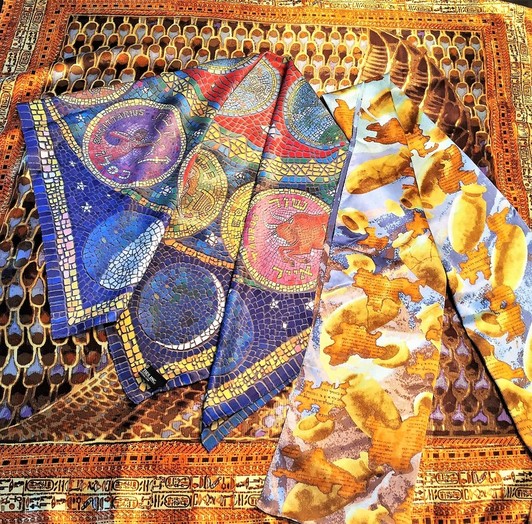The Zodiac Silk Scarf
$45.00
Throughout history people have shown an interest in the stars. The zodiac signs can be traced to Babylonian days. The ancient synagogue of Beit Alpha had in its center a marvelous mosaic floor with the 12 signs. The floor features the Hebrew names of the zodiac with the names of the Hebrew months. It is referred to as the Zodiac wheel and in Hebrew as galgal mazalot.
On Sale
On Sale
King Tutankhamun Falcon Feather and Golden Band Scarf
$45.00
$40.00
Scarves are no longer simply a square or long narrow strip of material worn for warmth round the neck or tied round the head. Covering the head had religious connotations among the Hindus, Jews, Christians, Parsis and Muslims. For many years Indian sari-pallav or the dupatta or odhani has served this purpose.
On Sale
On Sale
Qumran and The Dead Sea Scrolls Scarf
$45.00
$40.00
Scarves are no longer simply a square or long narrow strip of material worn for warmth round the neck or tied round the head. Covering the head had religious connotations among the Hindus, Jews, Christians, Parsis and Muslims. For many years Indian sari-pallav or the dupatta or odhani has served this purpose. But scarves have left behind the peasant-inspired look and have crashed onto the beaches, in colleges, evening out, day-time casual wear and the fashion magazines. They are in vogue and, along with bags, shoes, belts and jewelry, have become the accessories of the moment.
On Sale
On Sale
King Tutankhamun Burial Chamber Wall Ornament
$30.00
$15.00
This design is taken from the wall behind the casket around King Tut’s mummy in the burial chamber itself. Only the burial chamber received decorations. On the west wall are scenes depicting the apes of the first hour of the Amduat the Book of the Secret Chamber. In this book the dead pharaoh travels through the underworld to the afterlife in his solar boat.
On Sale
On Sale
King Tutankhamun War Chest Chariot Ornament
$30.00
$15.00
This design is taken from the wooden war chest which was found in the Antechamber of Tut’s tomb. It is one of the most intricately decorated objects in the tomb. Fierce confrontations take place on both sides of the chest. King Tut is depicted in his chariot trampling Hittites on one side and Nubians on the other. Both his horses leap forward, rearing on hind legs, wild eyed, crushing the enemy. Plumed headdresses rise from caps on the crests of the horses' necks.

